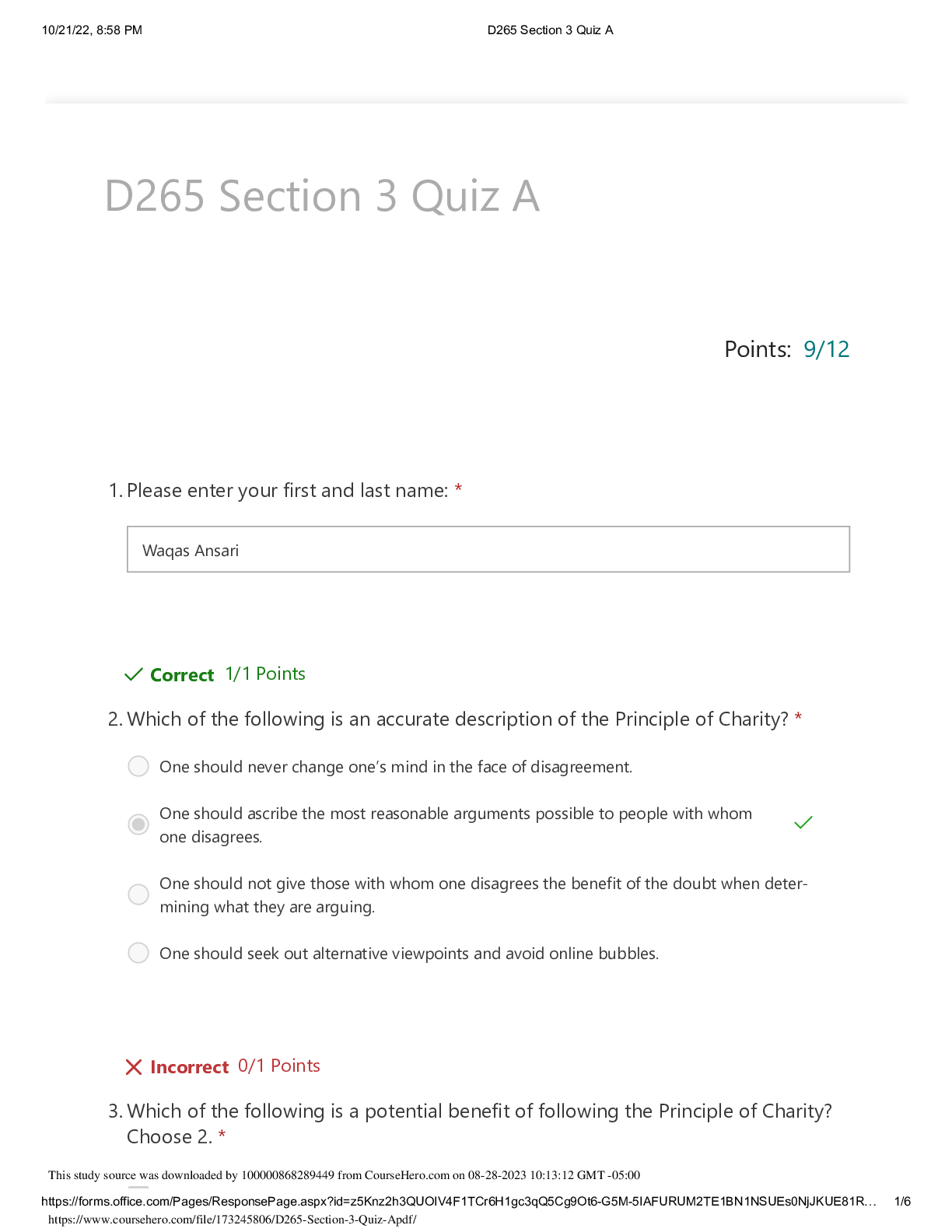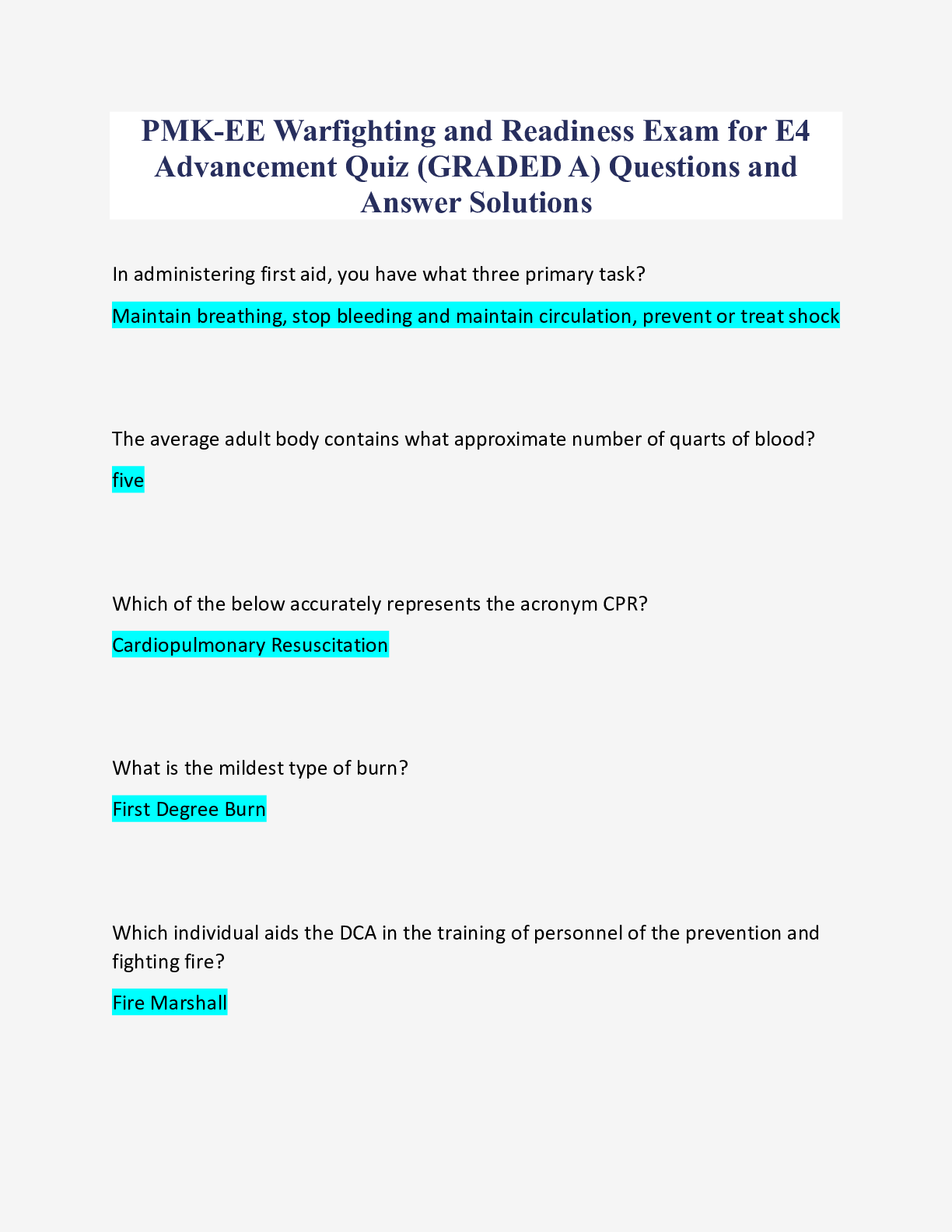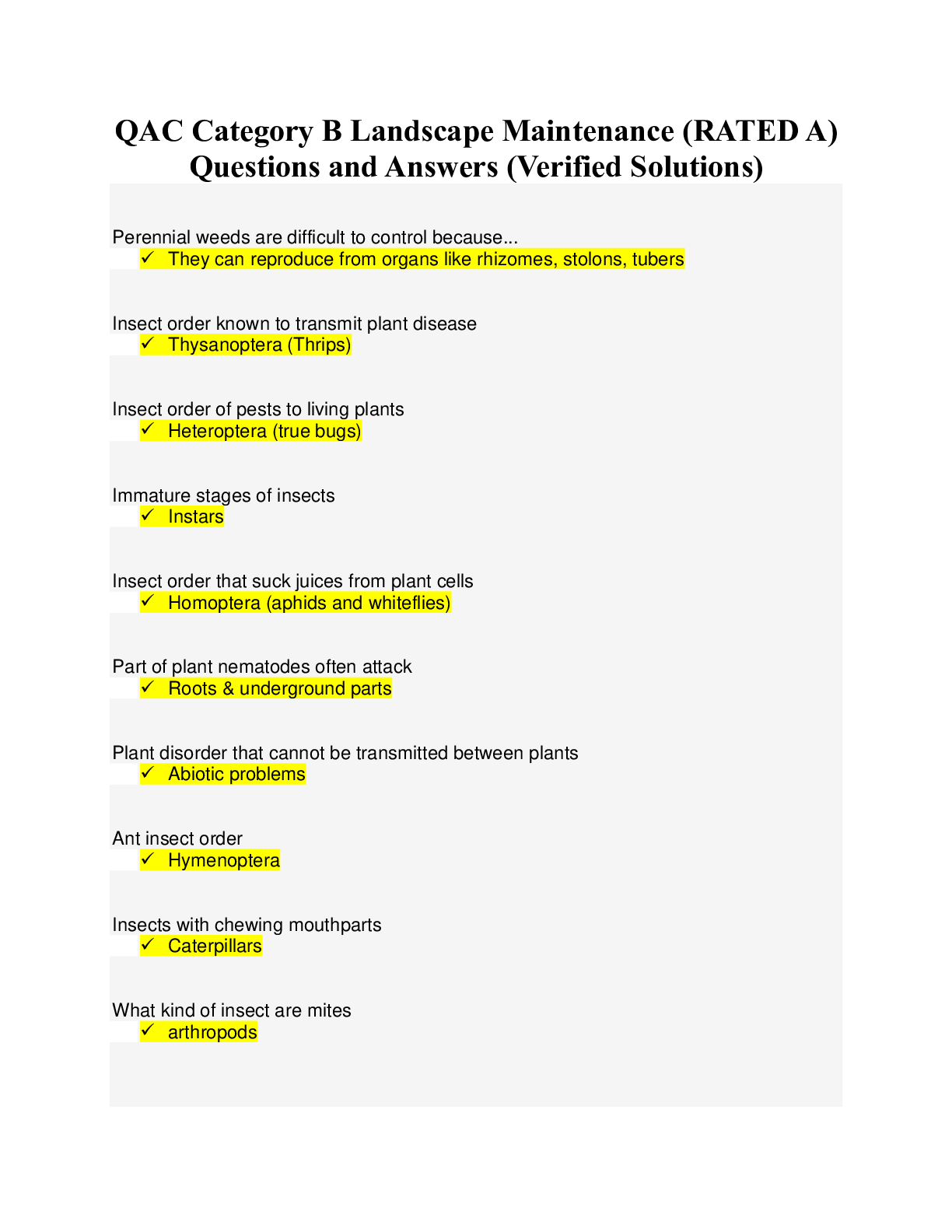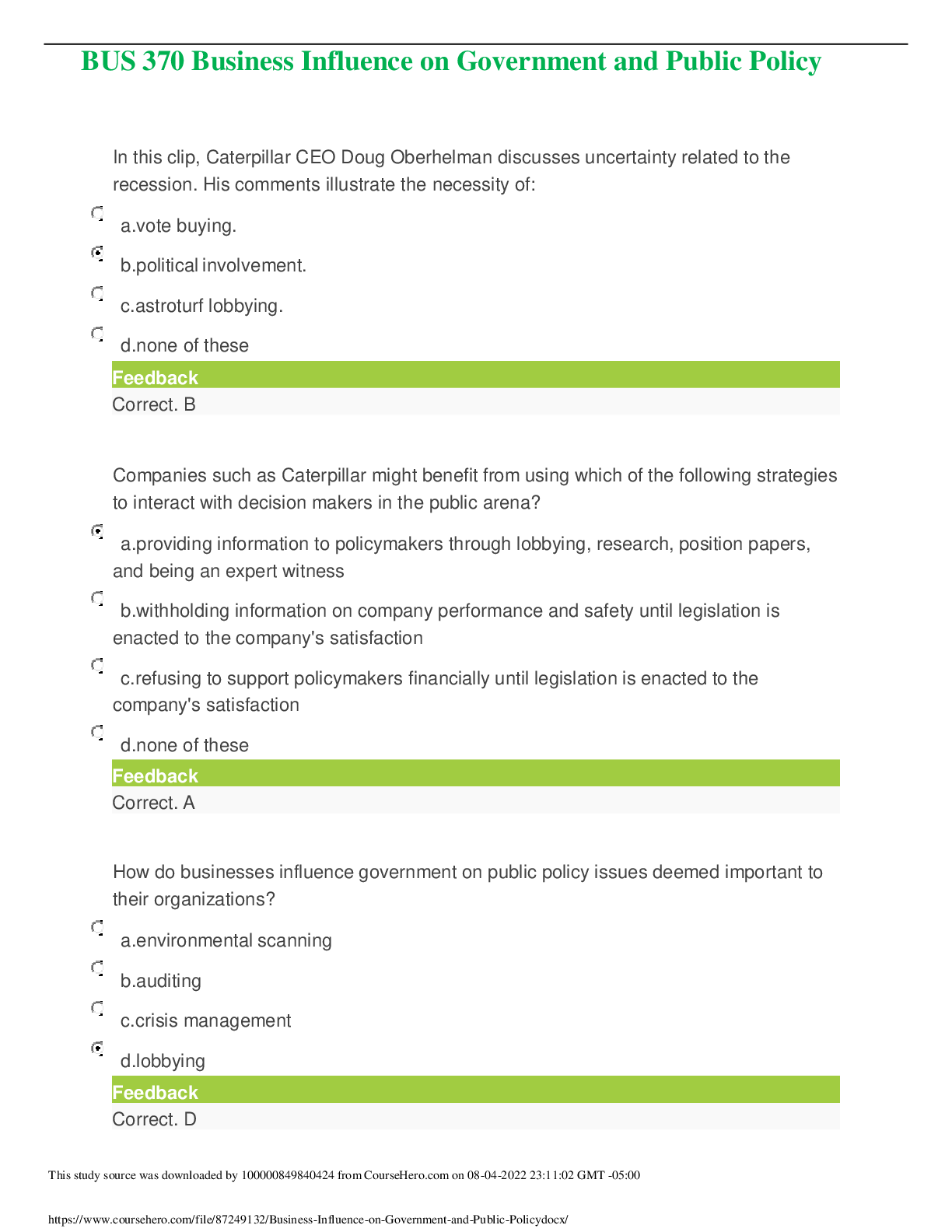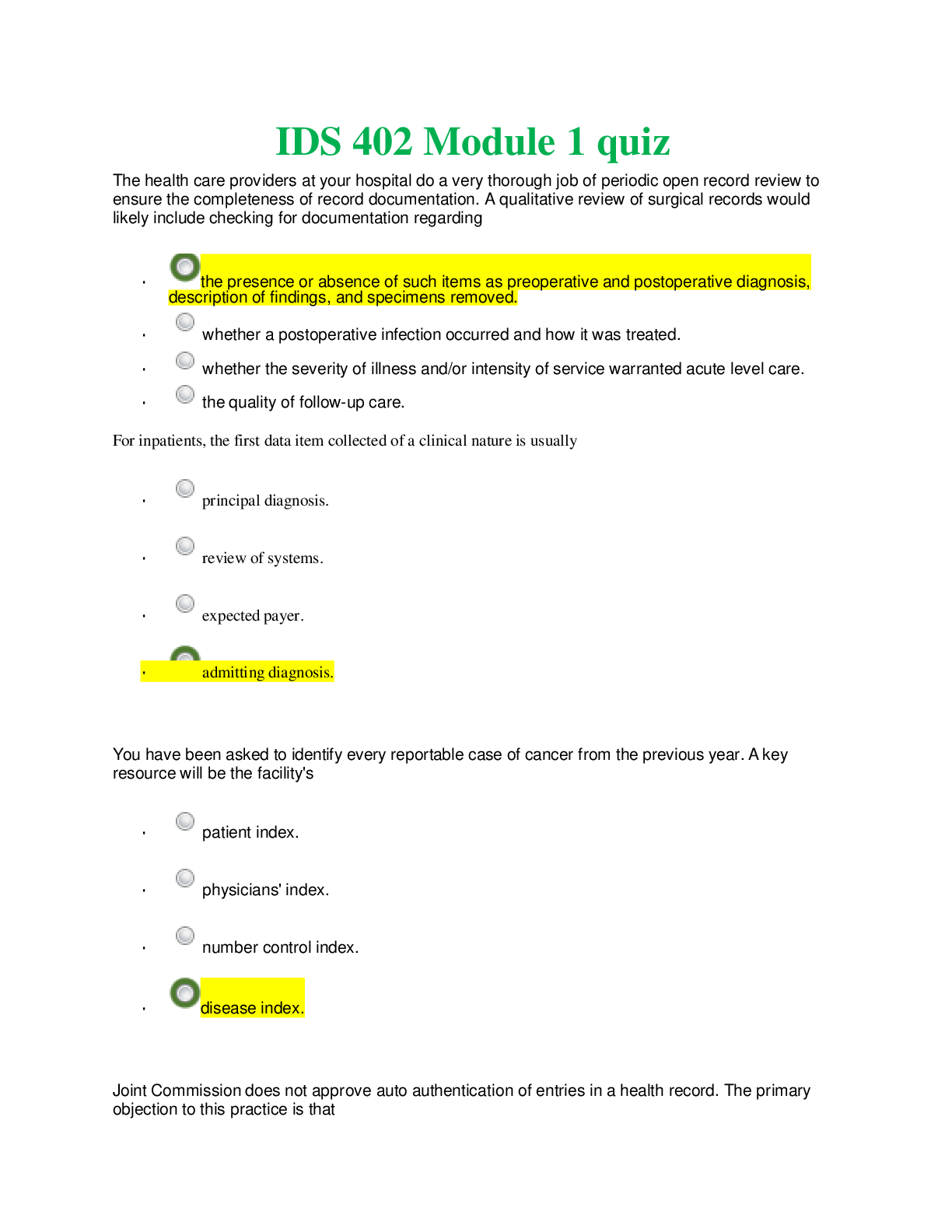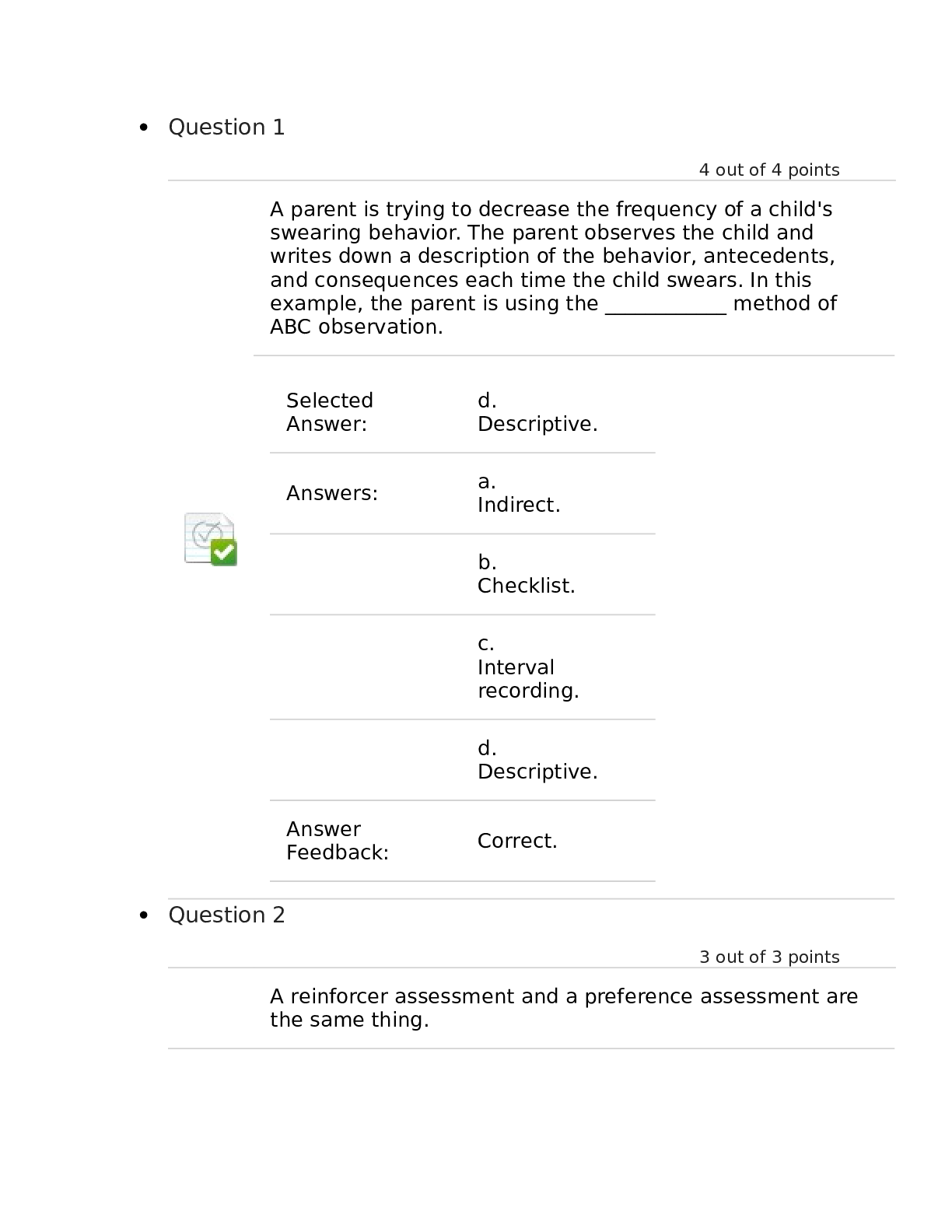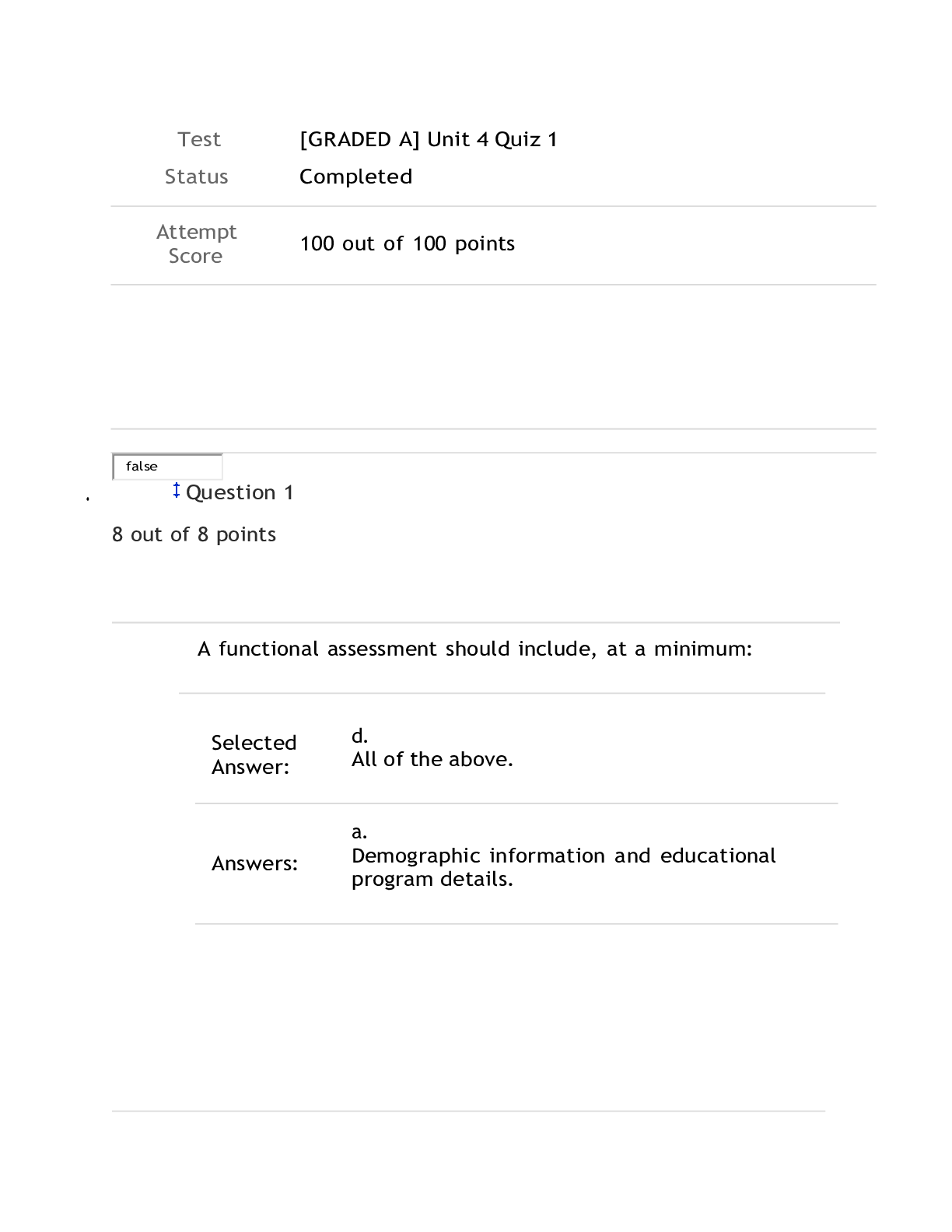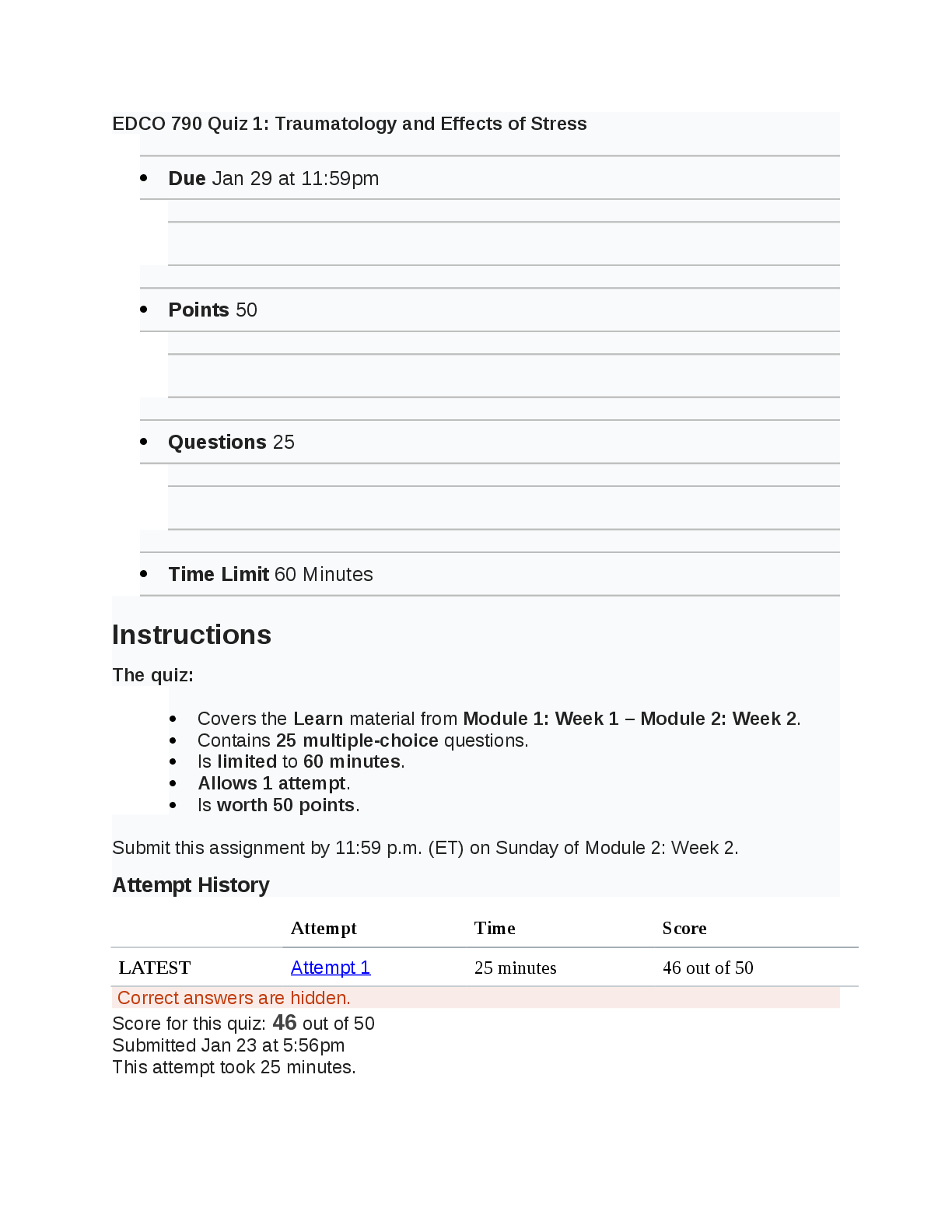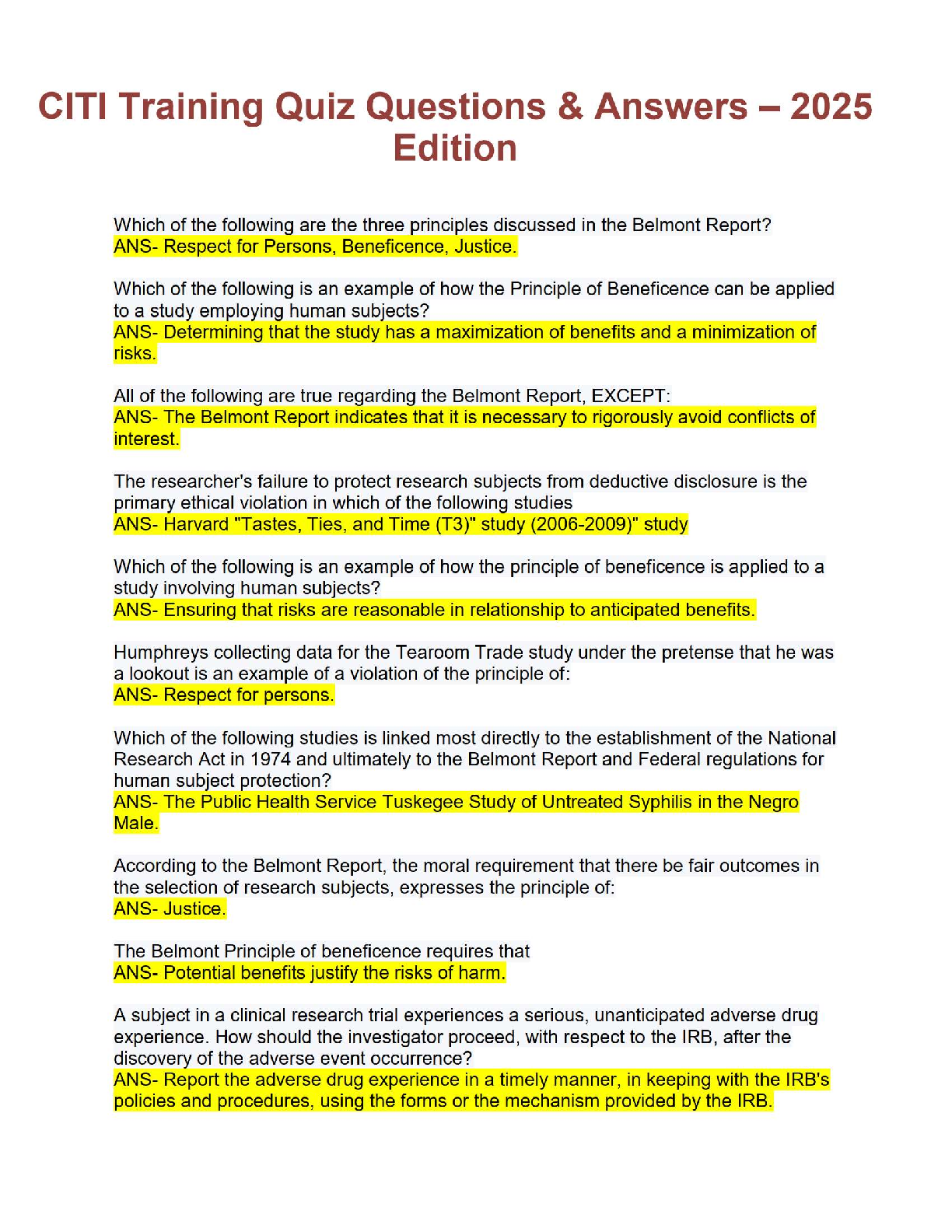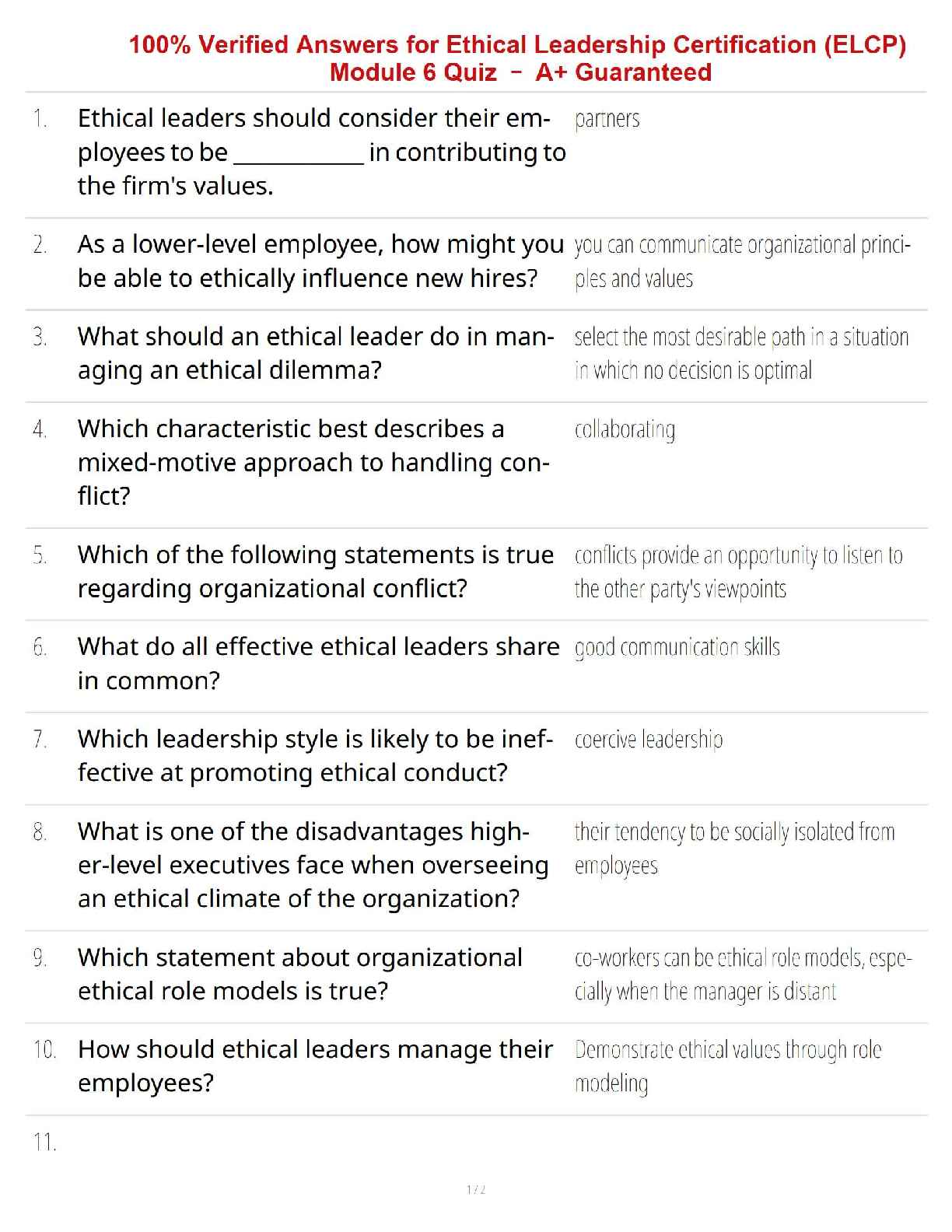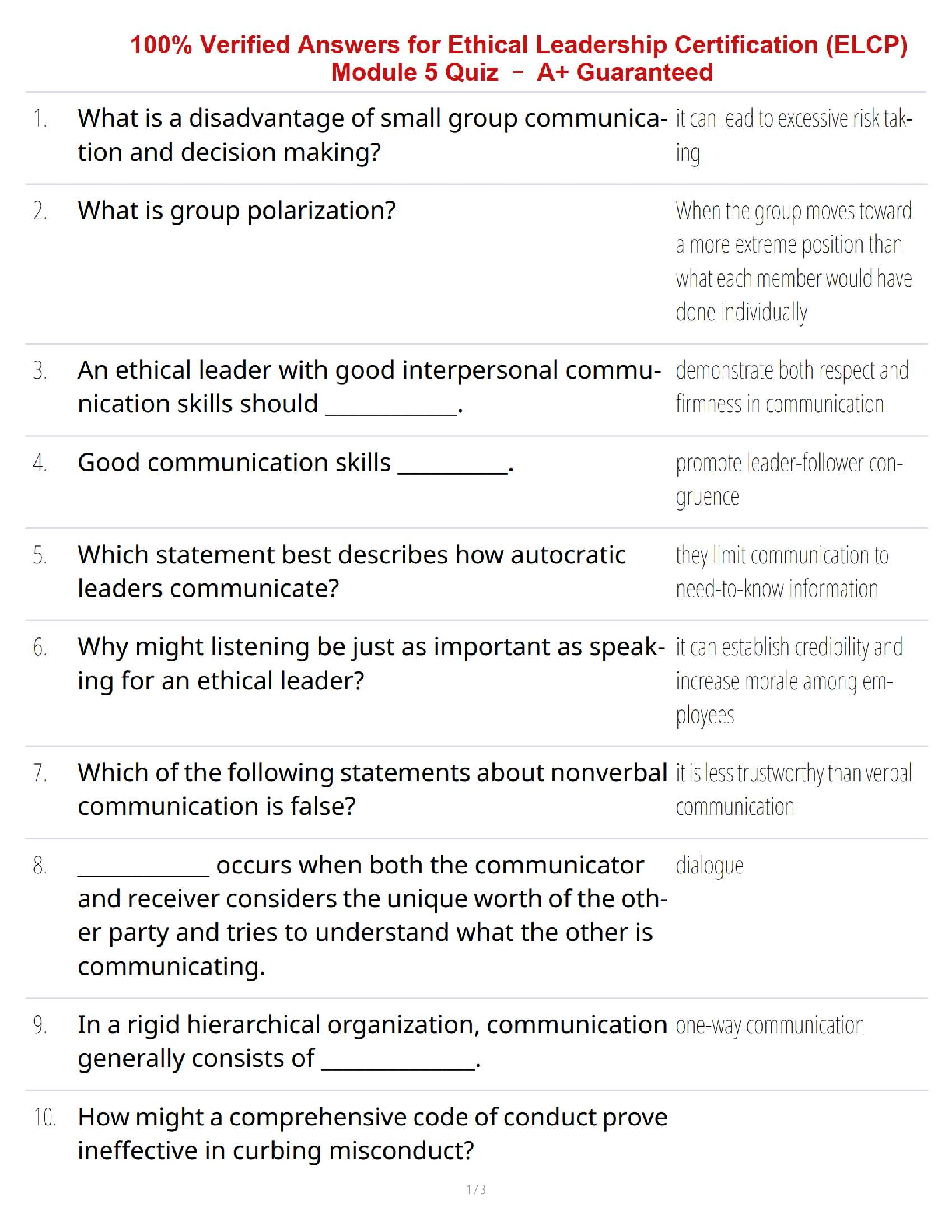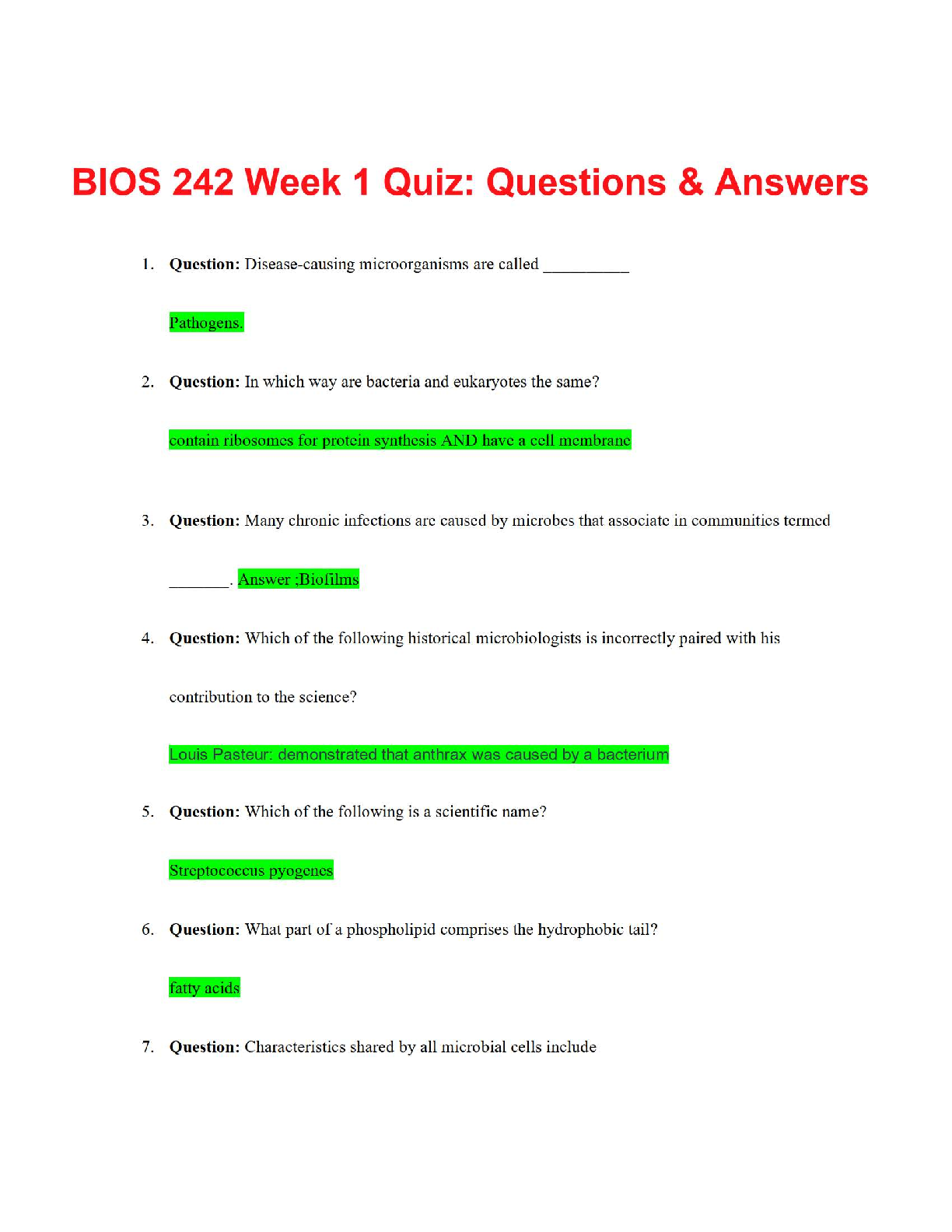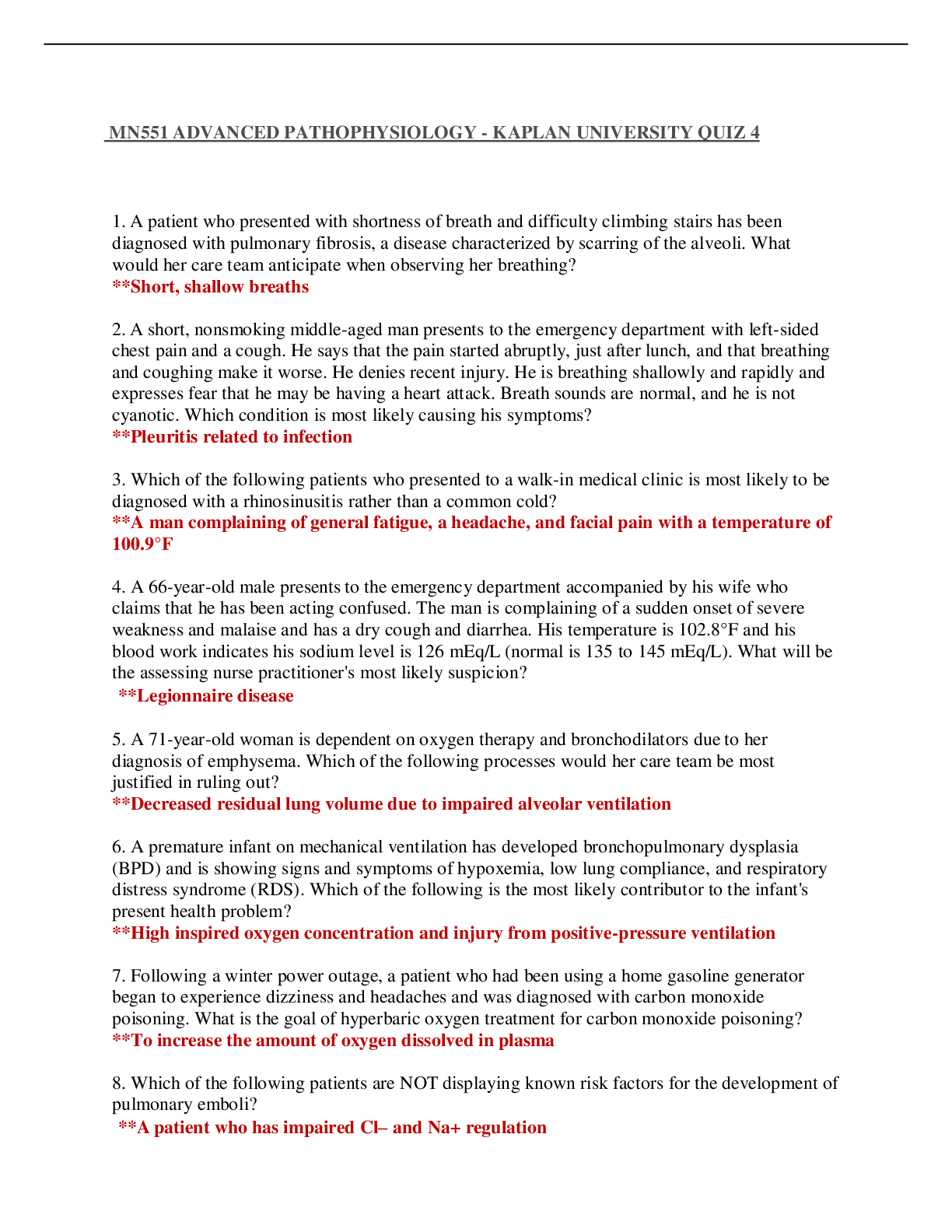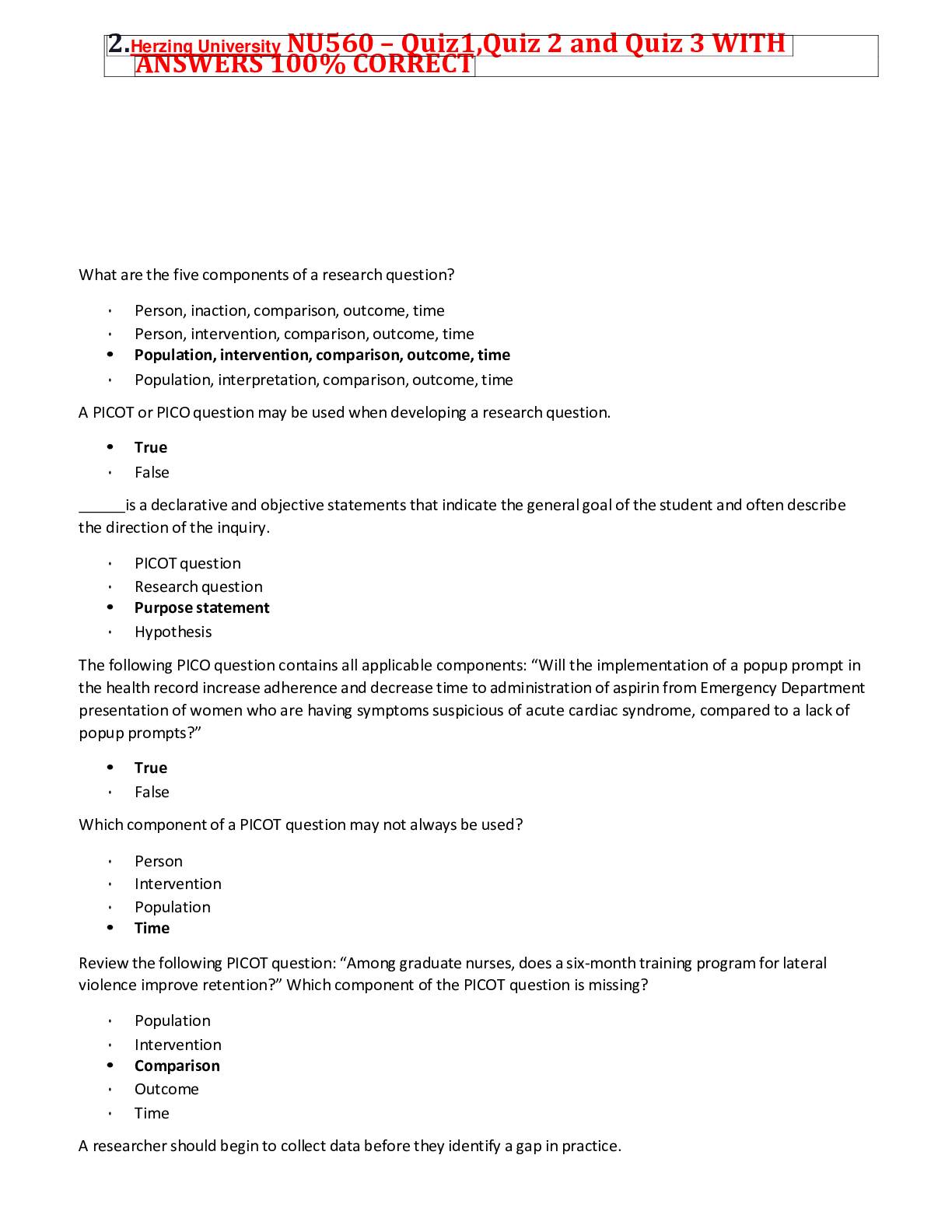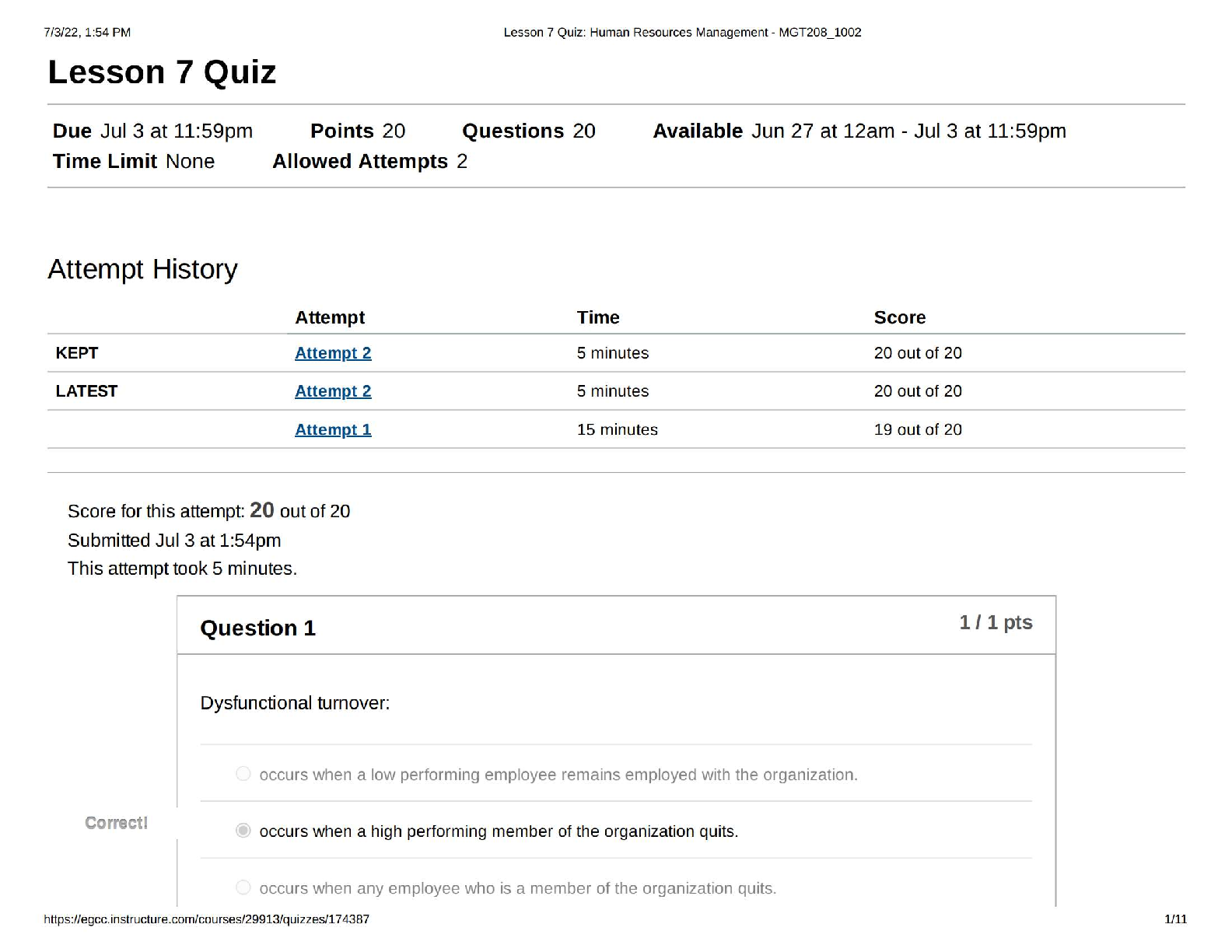Anatomy > Quiz > BIOS 195 Weekly Quizzes (Week 1 – 7) | Questions and Answers | 100 out of 100 | Guaranteed PASS (All)
BIOS 195 Weekly Quizzes (Week 1 – 7) | Questions and Answers | 100 out of 100 | Guaranteed PASS
Document Content and Description Below
BIO QUIZ (TCO 1) The process by which unspecialized cells become specialized cells is called Answer: differentiation (TCO 1) The release of insulin from pancreatic islet cells in response to an in ... crease in the blood glucose concentration after a meal is an example of which of the following life processes? Answer: Responsiveness (TCO 1) The plane that divides the body into unequal left and right portions is called a(n) Answer: parasagittal plane. (TCO 1) Which of the following is NOT one of the nine abdominopelvic regions? Answer: Right upper region (TCO 2) The most common type of chemical bond in the human body is Answer: the covalent bond. (TCO 2) In the human body, glycogen is commonly stored in the cells of the Answer: liver and skeletal muscles. (TCO 2) DNA and RNA are large polymers composed of repeating building blocks called Answer: nucleotides. (TCO 2) Which of the following is a common second messenger used in signaling pathways activated by water-soluble hormones? Answer: cAMP (TCO 2) Antidiuretic hormone and oxytocin are secreted from the Answer: posterior pituitary gland. (TCO 2) Which of the following types of cells found in the thyroid gland produce thyroxine? Answer: Follicular cells (TCO 3) The movement of solute molecules across a plasma membrane from an area of low solute concentration to an area of high solute concentration requires Answer: cellular energy and integral proteins. (TCO 3) Which of the following statements is NOT TRUE with regard to the cytoplasm? Answer: Responsible for nuclear division during mitosis (TCO 3) When translation of a particular protein is complete, termination of protein synthesis is indicated by the presence of a(n) Answer: stop codon. (TCO 3) The type of cell division that produces two identical cells is called Answer: somatic cell division. (TCO 3) A type of epithelial tissue containing cells that can change shapes as the tissue stretches is called Answer: transitional epithelium. (TCO 3) All of the following are classified as loose connective tissue EXCEPT Answer: elastic connective tissue. (TCO 3) Which of the following types of tissue contains neuroglia cells? Answer: Nervous tissue (TCO 3) Cells of the skin’s epidermis that participate in the immune response to microbes are called Answer: Langerhans cells. (TCO 3) Exocrine glands that secrete oil directly on to hair follicles are called Answer: sebaceous glands. (TCO 3) Which layer of skin contains large numbers of blood capillaries involved in body temperature regulation? Answer: Dermis (TCO 4) The layer of the GI tract wall containing networks of enteric neurons that control the secretory activity of the GI tract is called the Answer: submucosa. (TCO 4) Amylase is an enzyme secreted into the oral cavity to start the digestion of Answer: carbohydrates. (TCO 4) Storage of glycogen, vitamins (A, D, E, K), and minerals (iron and copper), along with detoxification of chemicals like ammonia, are functions of the Answer: Liver (TCO 4) Most of the nutrients have been absorbed from the chyme by the time it reaches the Answer: ascending colon. (TCO 4) The portion of peritoneum that anchors the small intestines to the posterior abdominal wall is called the Answer: mesentery. (TCO 4) Which of the following statements does NOT describe minerals? Answer: Most minerals can be synthesized by the body. (TCO 4) Which of the following hormones stimulates glycogen synthesis in liver and muscle cells? Answer: Insulin (TCO 4) When glucose is catabolized under aerobic conditions, the largest number of ATP molecules are directly produced by the Answer: electron transport chain. (TCO 4) The thermostat of the human body is located in the Answer: hypothalamus. (TCO 4) Which of the following hormones is the MAIN regulator of the basal metabolic rate? Answer: Thyroid hormone (TCO 6) The nervous system and the system share the greatest responsibility for maintaining homeostasis. Answer: Endocrine (TCO 6) The neuroglial cell that lines the ventricles of the brain and the central canal of the spinal cord is called a(n) Answer: ependymal cell. (TCO 6) Which of the following statements best describes the events that lead to depolarization of a neuronal membrane? Answer: Sodium flows into the neuron. (TCO 6) The subarachnoid space is located between the Answer: arachnoid mater and pia mater. (TCO 6) In someone who suffered a stroke that interfered with their ability to speak, the damage could involve any of the following areas in the brain EXCEPT the Answer: occipital lobe. (TCO 6) Which of the following best describes a characteristic of the pineal gland? Answer: Secretes a hormone that promotes sleepiness (TCO 6) Temporary cerebral dysfunction caused by a decrease in blood flow to one portion of the brain that usually leaves no permanent damage is called Answer: a transient ischemic attack. (TCO 7) The sensation of itch results from the stimulation of Answer: free nerve endings. (TCO 7) Which of the following structures is part of the vascular tunic of the eye? Answer: Iris (TCO 7) The sensors for maintaining dynamic equilibrium are located in the Answer: semicircular ducts. (TCO 8) An increase in the number of white blood cells is called Answer: leukocytosis. (TCO 8) The threads that hold a blood clot together are formed by Answer: fibrin. (TCO 8) Which of the following vessels carries blood with the highest concentration of oxygen under normal conditions? Answer: Pulmonary veins (TCO 8) Atherosclerosis is a condition in which Answer: fatty deposits called plaques partially block the arteries. (TCO 8) The endothelium that lines all blood vessels consists of Answer: simple squamous cells. (TCO 8) Under normal conditions, blood pressure is highest in the Answer: arteries. (TCO 8) Which of the following arteries branch directly from the brachial artery? Answer: Radial artery (TCO 9) The exchange of gases that occurs during external respiration takes place in the Answer: alveoli. (TCO 9) Deep labored inhalations involve contraction of all of the following muscles EXCEPT the Answer: internal intercostals. (TCO 9) Under resting conditions, the basic rhythm of breathing is controlled by the Answer: medulla oblongata. (TCO 10) The peritubular capillaries drain directly into the Answer: cortical radiate veins. (TCO 10) The glomerular filtration rate in a normal adult male is about Answer: 180 liters a day. (TCO 10) All of the following are solutes normally found in urine EXCEPT Answer: albumin. (TCO 10) The tubular structure that connects a kidney to the urinary bladder is the Answer: ureter. (TCO 10) Inflammation of the glomeruli of the kidney is referred to as Answer: glomerulonephritis. (TCO 10) All of the following are true about testosterone EXCEPT Answer: it stimulates FSH release from the anterior pituitary gland. (TCO 10) All of the following hormones are involved in promoting and regulating various aspects of lactation EXCEPT Answer: dehydrotestosterone (DHT). (TCO 10) Menstruation is directly caused by a decrease in the ovarian secretion of Answer: progesterone and estrogen. (TCO 10) All common forms of oral contraceptives contain a drug that mimics the regulatory effects of Answer: progesterone. (TCO 10) Absence of menstruation is called Answer: amenorrhea. [Show More]
Last updated: 3 years ago
Preview 1 out of 4 pages
.png)
Buy this document to get the full access instantly
Instant Download Access after purchase
Buy NowInstant download
We Accept:

Reviews( 0 )
$13.50
Can't find what you want? Try our AI powered Search
Document information
Connected school, study & course
About the document
Uploaded On
Nov 03, 2022
Number of pages
4
Written in
All
Additional information
This document has been written for:
Uploaded
Nov 03, 2022
Downloads
0
Views
157

